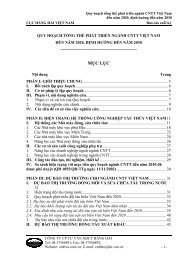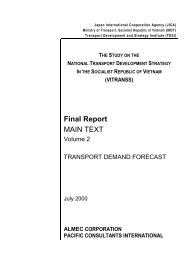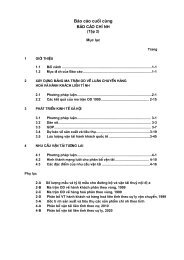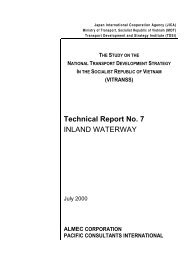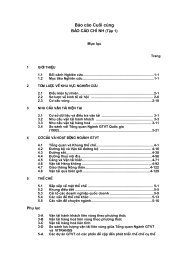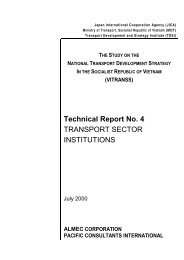Table 3.5.3 Estimated Business Results in 1998 II-3-16 Vietnam National Transport Strategy Study (VITRANSS) <strong>Technical</strong> <strong>Report</strong> <strong>No</strong>. 8 Shipping and Ports Turnover (VND mil.) Profit, Loss (VND mil.) Contribution to State Budget (VND mil.) Subsidiary Enterprise Plan 1998 Actual 1997 Estimated 1998 Compare % 1997 1998 Actual 1997 Estimated 1998 Compare 1997 Plan 1998 Actual 1997 Estimated 1998 Compare % 1997 1998 1 VN shipping Co. 440,000 463,398 462,500 100% 105% 3,426 8,000 234% 10,000 8,874 12,000 135% 120% 2 Maritime shipping Co. <strong>No</strong>. III 90,000 76,020 98,784 130% 110% 1,423 3,300 232% 3,500 2,695 4,300 160% 123% 3 VN Oil Transport Co. 150,000 122,647 156,404 128% 104% 4,593 520 11% 7,500 7,960 7,266 91% 97% 4 VITRANSCHART 250,000 241,080 264,878 110% 106% 2,199 1,202 55% 9,000 9,149 9,589 5 Ocean-River going Corp. 35,000 30,215 35,989 119% 103% -4,746 0 700 74 734 105% 107% 109% 105% 6 <strong>No</strong>rthern Shipping Co. 17,000 21,689 16,511 76% 97% 30 33 110% 500 633 417 66% 83% 7 VINALINES fleet 151,300 103,849 178,479 172% 118% 1,017 1,000 98% 3,000 2,783 4,453 160% 148% TRANS<strong>PORT</strong>ATION SECTOR TOTAL 1,133,300 1,058,898 1,213,545 115% 107% 7,942 14,055 177% 34,200 32,768 38,759 118% 113% 8 Hai Phong Port 280,000 263,963 284,500 108% 102% 42,575 49,974 117% 34,000 34,048 34,263 101% 101% 9 Quang Ninh Port 20,200 14,251 19,918 140% 99% 813 870 107% 2,000 1,347 1,603 10 Saigon Port 380,000 378,831 380,000 100% 100% 57,541 57,532 100% 40,000 39,622 40,000 11 Danang Port 44,200 45,461 50,000 110% 113% 4,102 4,500 110% 3,200 3,757 4,000 12 Can Tho Port 7,300 5,869 8,600 147% 118% 665 1,200 180% 680 679 947 119% 80% 101% 100% 106% 125% 139% 139% <strong>PORT</strong> SECTOR TOTAL 731,700 708,375 743,018 105% 102% 105,696 114,076 108% 79,880 79,453 80,813 102% 101% 13 VOSCO 100,000 109,597 109,718 100% 110% 19,872 19,099 96% 26,400 27,224 29,570 109% 112% 14 <strong>No</strong>rthern container Co. 28,000 24,420 32,000 131% 114% 2,483 2,800 113% 2,400 2,355 2,500 106% 104% 15 Southern Container Co. 36,000 34,961 41,550 119% 115% 7,701 11,300 147% 7,000 9,761 7,000 72% 100% 16 Shipping supply Co. <strong>No</strong>. I 6,000 2,369 6,823 288% 114% -38 -765 500 521 345 66% 69% 17 Southern Shipping Co. 4,000 2,885 3,795 132% 95% 0 116 20 515 334 65% 64% 18 Southern Petrol Supply Co. 7,100 4,469 8,000 179% 113% 246 106 43% 850 671 850 19 INLACO 15,000 14,549 15,250 105% 102% 150 850 567% 750 565 764 20 Southern INLACO 57,000 46,931 58,160 124% 102% 10,719 11,530 108% 10,000 8,690 13,300 127% 100% 135% 102% 153% 133% 21 Shipping Development Co. 21,000 19,992 21,300 107% 101% 2,496 2,800 112% 3,100 2,496 3,300 132% 106% 22 Maritime Informatics & Techno. Co 2,000 1,450 1,600 110% 80% 2 5 250% 45 41 52 127% 116% 23 HP Shipping supplies & Exp.-Imp co. 5,000 4,407 5,020 114% 100% 201 200 100% 760 793 833 105% 110% 24 Southern Shipping Supplies & Exp.-Imp 600 562 315 56% 53% 38 60 158% 85 84 58 69% 68% 25 Maritime Trade Center I 1,500 1,476 1,318 89% 88% 30 22 73% 60 47 32 68% 53% 26 Maritime Trade Center II 1,800 1,608 3,833 238% 213% -216 -361 240 227 251 111% 105% 27 Maritime Industrial Service Co. 6,000 5,789 6,000 104% 100% 20 50 250% 111 67 115 172% 104% SERVICE SECTOR TOTAL 291,000 275,465 314,682 114% 108% 43,704 47,812 109% 52,821 54,057 59,304 110% 112% VINALINES GR<strong>AND</strong> TOTAL 2,156,000 2,042,738 2,271,245 111% 105% 157,342 175,943 112% 166,901 166,278 178,876 108% 107% Source: VINALINES – Annual <strong>Report</strong> in 1999 <strong>No</strong>te: Data collected through interviews with enterprises from 20 December to 26 December 1998.
4 DISCUSSIONS ON KEY PLANNING ISSUES 4.1 Assessment of Existing Port Capacity II-4-1 Vietnam National Transport Strategy Study (VITRANSS) <strong>Technical</strong> <strong>Report</strong> <strong>No</strong>. 8 Shipping and Ports Several types of ports are handling general cargo. Ports managed by the MOT usually handle public cargo while private ports serve limited users. In this section the capacity of the 89 ports is analyzed. The total capacity of general ports in 1998 is 36.2 million tons – 6.6 million tons in northern ports, 7.2 million tons in central ports and 21.2 million tons in southern ports. In the same year, general cargo volume handled by these ports is estimated at 28.1 million tons – 6.6 million tons in northern ports, 3.4 million tons in central ports and 18.0 million tons in southern ports. Compared with neighboring countries, Vietnam’s general ports are comparatively small. The eight major general ports have shallow water depth ranging from five to 11 m. Their combined length of berth of 8,267 m is, for example, roughly equal to that of Tanjung Priok Port (8,911 m), Port Klang (8,648 m) and Manila Port (7,592 m). But this is to be expected of gateway ports; modern berths for exclusive containers and 30,000 DWT vessels or larger are necessary to accommodate international transport chains. Besides port capacity, the following weaknesses of Vietnamese ports must be pointed out: • Port operation is unreliable. There are several factors which contribute to this bad reputation: limited navigable time, non-availability or lack of wellmaintained cargo-handling equipment, lack of trained port labor, inadequate supervision and management, and lack of incentives and unclear port charges 1 . Foreign operators face difficulty in giving “dispatch money” to port labor and management to achieve faster results. • Ships must sail with insufficient ATNs and SAR services. In fact, there is still a “black sea” on Vietnamese waters where no visual aid is available. Meanwhile, the Vietnam Maritime SAR Coordination Center does not possess any SAR fleet and oil spill protection equipment. • Proper attention has not been given to policy setting in port development, allowing implementation to go unguided by an overall policy on the subsector. Port construction randomly done wastes precious funding sources. Major ports cannot expand facilities by self-financing from port charges or relying on external resource and technology alone. 1 One state-owned operator reported that in 1998 they suffered from demurrage of 1,122 days from operating 21 general cargo vessels, mainly due to wasteful waiting time for high tide and poor cargo-handling services.



